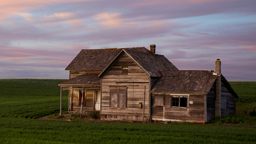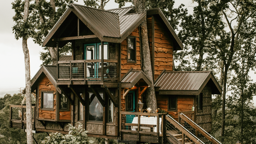Let’s say you’ve recently bought a cabin, complete with several forested acres. You move in, settle down on the deck with a cold beverage, gaze out over your new woodlot and think, “Well, that’s that! Nothing more to do.”
Not so fast, say foresters around the country.
“To those landowners considering buying a piece of property in the forest, I say it’s both exciting but also a very large responsibility,” says Angela Wells, Stewardship Program Manager with the Montana Department of Natural Resources and Conservation. “Just as if you bought a home with a massive lawn and a fancy garden you would incur some maintenance responsibilities, you also incur maintenance responsibilities when you buy a piece of property in the woods.”
While cabin owners may think that the best approach to maintaining a forest in a natural state is to be hands-off and just let it run wild, that’s generally not the case. The reality is that by living there, we inherently alter the way a forest functions – and alter the forest’s ability to behave in an entirely natural way. As a result, invasive species, habitat fragmentation, fire suppression and development have all substantially changed forests across North America.
The Benefits of Active Private Woods Management
“When people move into the forest, they are, just by virtue of their very presence, disrupting natural processes,” says Wells. “One of the biggest benefits of active management is that we can replicate and emulate the natural processes that we’ve altered.”
By actively managing forests, landowners can enhance habitat for wildlife, improve forest health, mitigate for wildfire risk, and allow their land to contribute what are known as “ecosystem services” – that provide important things like clean water and air quality. But it’s one thing to talk about active management, and it’s another thing entirely to implement it on the landscape. Forestry projects can appear daunting to the average landowner, and the questions pile up quickly: Where to begin? Who to talk to? What does “active management” even entail?

Joanne Francis / Unsplash
Help is Available
Luckily, would-be forest stewards don’t have to look too far to find guidance. “Quite simply, our goal is to help landowners practice good forest stewardship in their woods,” says John Carlson, Private Forest Management Coordinator with Minnesota’s Department of Natural Resources. “That can mean a number of different things, depending on what the landowner wants to do.”
Nearly every state forestry agency is staffed with foresters whose job is not only to help private landowners make choices about being good stewards of the land but also to offer guidance as the landowners wade through the quagmire of jargon, acronyms, assistance programs and management choices that exist. Should you choose state or federal assistance? What is NRCS? What’s a CRP? What’s EQIP? Or CAP106, or SFIA? It’s enough to boggle the mind, and set even the most forest-savvy landowners to scratching their head.
Addressing Key Private Woods Questions
Don’t worry, say both Wells and Carlson. The first step is simply to address a few key questions about your property:- What condition is my forest in now?
- What areas need improvement?
- What are my end goals for my forest – do I want to manage for timber harvest? For wildlife habitat? For fire mitigation? Most likely it will be a combination of goals, and that combination will determine the next steps.
Many landowners already have a decent sense of the current condition of their forest, as well as their hopes for its future, but it’s always helpful to bring in a professional early in the process. Wells often consults with landowners well before they formulate a stewardship plan. “I start out by saying, ‘Tell me about your property. What do you like about it? How long have you been here?’ And then, we transition into what they see as challenges or areas that need some work. And then as a forester, I help them with the language to describe those goals.”
Write a Management Plan
Having the right language to describe your management goals is a critical piece of the puzzle. Not only does it help ensure that everyone is on the same page but in order to take advantage of state and federally funded forestry assistance programs, a homeowner must have a written plan in place regarding the condition and prescription for their forest.
“In Minnesota, it’s called the Woodland Stewardship Plan,” explains Carlson. “It’s where the forester meets with the landowner, discusses their goals, and writes a management plan.” While the logistics of this process vary by state (for instance, Minnesota uses private contract foresters for this work, while Montana utilizes state foresters), the results are similar: Cabin owners end up with a professional assessment of their forest and an outline of the work and steps that would be required to manage that forest in accordance with their goals.

Irina Iriser / Unsplash
Decide on Next Steps
From this point, the landowner needs to decide – often in consultation with a forester – what those next steps are. In some instances, simply having a management plan is enough to help the landowner care for the property on his/her own and even gain some nice tax breaks. In other instances, larger-scale work may be appropriate. “There are lots of options for projects – planting trees, actively managing for wildlife and doing timber stand improvement, such as thinning or harvesting,” says Carlson, “ And there are often options for landowners to receive assistance for these projects.”Apply for Grant Money
Landowners can apply for cost-sharing grants on either the federal or state level. At the federal level, agencies such as the Natural Resources Conservation Service (the mysterious NRCS mentioned above) provide incentives, grants and assistance for management projects that address key resource goals, such as improved wildlife habitat, reduced soil erosion, and ground water conservation.
At the state level, cost-sharing grants may be geared toward a wide variety of projects. Some are simply earmarked for general forest management, while others focus on more specific goals. For instance, Wells mentions that in Montana and many other wildfire-prone western states, most state-level funding is allocated to fire-adapted ecosystem restoration or hazardous fuel reduction. In Minnesota, meanwhile, Carlson says that there are ample opportunities for landowners who are interested in converting land previously used for agricultural purposes back into forest or prairie habitat.
Step Up
Wells and Carlson both stress the importance of landowner participation when it comes to the success of large-scale conservation and sustainable forestry practices. As landscapes across the nation become more fragmented, it’s imperative that individuals step up, avail themselves of the many resources out there and take an active interest in the health and maintenance of their forest.
“If you love the woods and you want to live in the woods, be ready for managing your woods to become your hobby,” says Wells with a laugh. “It might not be what you do with 100% of your time, but if you’re doing it right and being a responsible steward, it will be what you do with a lot of your time.”
Frequent contributor Melissa Mylchreest lives, writes and plays in western Montana.










